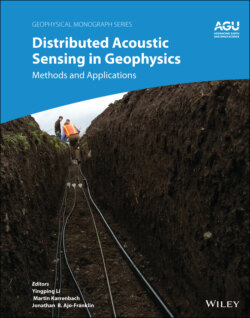Читать книгу Distributed Acoustic Sensing in Geophysics - Группа авторов - Страница 46
2.5. PREPROCESSING ISSUES 2.5.1. Fading
ОглавлениеOne unique property of all DAS data, compared to conventional seismic data, is the occurrence of channel fading, which is also called “vertical noise” because it appears as vertical stripes on a record where time is plotted on the vertical axis and channel number (or depth) on the horizontal axis. As discussed in the IU section, relative strain data are computed from the I and Q traces. The stability of extracting the phase term using Equation 2.1 depends upon the signal fidelity of both the I and Q traces. Because of the interaction of the backscattered light created from the distribution of random scattering sites in the fiber, there are occasions when the intensity of the backscattered light is low, causing the length (modulus) of the I/Q vector to be comparatively small in numerical value (Figure 2.2, right) and thus more subject to noise. This, in turn, makes taking the arctangent of Q/I to become extremely noisy. While the computation of the arctangent is stable, the phase‐unwrapping algorithm is unable to determine the appropriate value of π to add to the phase to create a continuous signal, creating unexpected jumps in phase at these times on the trace.
The occurrence of fading changes in both time and distance along the fiber; for example, extremely small changes in the fiber’s temperature move the scattering sites and cause temporary dimming of the backscattered signal at new locations. It has been observed (Ellmauthaler et al., 2016) that approximately 3% of the fiber is faded at any given moment; for example, if the sensing fiber has 5,000 channels, that translates to as many as 150 channels exhibiting some form of fading. However, even during small time intervals of approximately 1 min, the fading on the affected channels will move. Thus, if it is possible to repeat the source and take multiple measurements, it is easy to obtain reliable data eventually without fading.
Figure 2.5 shows simulated fading on a single channel. The top panel shows the I trace (blue) and Q trace (orange). In addition to the desired seismic signal, a temperature drift was simulated by a long period trend. Notice that, between 2 and 2.25 sec, the amplitudes of both I and Q traces diminish toward zero. The middle panel shows the resulting relative strain trace computed from the I and Q traces. The relative strain trace is continuous and smooth before and after this time interval. However, during the dimmed interval, it is evident that the phase‐unwrapping algorithm has failed to unwrap the phase properly, and multiple non‐physical jumps in the strain trace occur. Notice that the temperature drift shows up as a background “ramp” on the relative strain data. The bottom panel shows the strain rate trace, which is simply the time derivative of the relative strain trace. Jumps in the relative strain trace become negative and positive spikes in the strain rate trace. The strain rate data is not as sensitive to the temperature drift since the time derivative is similar to a low‐cut filter and has greatly reduced the long period temperature ramp.
Figure 2.5 (Top) I (blue) and Q (orange) traces; (middle) corresponding relative strain; (bottom) strain rate.
It is difficult to perform conventional processing and analysis of the resulting seismic data without addressing these faded channels in either the relative strain or strain rate data. Figure 2.6 shows an example of strain rate DAS VSP data collected using a vibrator source with a 12 sec sweep and 4 sec listen time. The top two panels for Figure 2.6 show an uncorrelated trace without and with fading, respectively. Notice the spikes between 10 and 12 sec on the faded trace. The bottom two panels on Figure 2.6 show the corresponding correlated traces; it is evident that the spikes in the faded trace have affected the entire trace because of the correlation process. For land data, where it is possible to acquire multiple sweeps at the same shot point, the spikes caused by fading can be mitigated using a weighted stacking of the sweeps, which minimizes large amplitude spikes. For marine data, where typically only one “pop” is acquired at each shot point, a despiking algorithm can be used to remove the faded portions of the trace before further processing and analysis.
In addition to weighted stacking of the sweeps, another approach can be used when acquiring data. The response of the fiber to fading depends on the frequency of the laser light used. If two or more different frequencies of light are used to simultaneously acquire the same strain measurements in the fiber, the locations of the fading will most likely be different because of the disparate frequency sensitivities of the light to the scattering points in the fiber. Figure 2.7 shows the VSP strain rate data sets acquired using two frequencies. Figures 2.7a and 2.7b show the records using frequencies 1 and 2, respectively—notice that the locations of the fading are different between the two records. Figure 2.7c shows the result of the weighted stacking of data from two frequencies. A significant reduction in the number of faded channels can be observed by combining data acquired with more than one frequency of light. For clarity, Figure 2.7d shows the three traces (frequency 1, frequency 2, and weighted stack) for each of two channel locations (109 and 221). For channel 109, the frequency 1 data (in red) is faded; and, for channel 221, the frequency 2 data (in red) is faded. Thus, the weighted stack (in black) favors the non‐faded trace (in blue).
